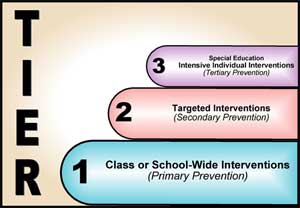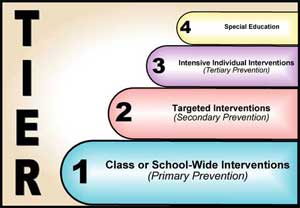How can Tier 3 intervention be conceptualized in the RTI approach?
Page 2: Characteristics of the RTI Approach
 The RTI approach is a general education initiative. However, it requires that general and special education teachers work together to provide effective instruction and to ensure that students who are struggling academically receive high-quality instruction in the general education classroom. RTI uses a prevention and intervention model as opposed to the traditional model of identifying students, which most schools have used for years and has been criticized as a “wait to fail” model. The table below compares these two models.
The RTI approach is a general education initiative. However, it requires that general and special education teachers work together to provide effective instruction and to ensure that students who are struggling academically receive high-quality instruction in the general education classroom. RTI uses a prevention and intervention model as opposed to the traditional model of identifying students, which most schools have used for years and has been criticized as a “wait to fail” model. The table below compares these two models.
| RTI Model | Traditional Model |
| Early identification of SLD (e.g., first grade) | Later identification of SLD (e.g., fourth grade) |
| More collaboration between general education and special education | General education and special education operate somewhat independently |
| Provides opportunities for additional instruction for struggling students; many of whom are from culturally and linguistically diverse populations | Potential for disproportionate representation of diverse students in special education |
| Receiving intervention is not conditional on being identified as having a disability | Receiving intervention often requires that a student qualify for special education services |
| Smaller student group sizes for Tier 3 (e.g., 1 to 3 students) | Crowded special education classrooms |
| Explicit focus on using high-quality instruction (e.g., research-validated strategies) | Under use of evidence-based practices |
| Frequent progress monitoring (e.g., formative assessment) in addition to summative assessments | Primarily summative assessments |
|
x
formative assessment glossary x
summative assessment glossary |
|
As noted in the table, the RTI approach varies greatly from the traditional way of meeting the instructional needs of students. As a result, Katy Stromwell and her team, like other practitioners, have questions about how the needs of struggling students and those who require special education services will be met within the RTI approach.
For Your Information
The RTI approach requires greater collaboration among school personnel than does the traditional model. As a consequence, some professional roles may shift. For instance, school psychologists might prove instrumental in interpreting progress monitoring data and helping to make data-based decisions.
Common RTI Models
RTI is being implemented in schools across the country in a number of ways. Although the U.S. Department of Education has not endorsed a specific RTI model, in practice two models have emerged as the most common—a three-tiered model and a four-tiered model. Both consist of at least three tiers of intervention (i.e., primary, secondary, and tertiary), but they differ in how they deliver tertiary intervention. In a three-tiered model, tertiary intervention is delivered through the special education program. However, in a four-tiered model, tertiary intervention is typically delivered through the general education program, and special education services are delivered at the fourth tier. These models are compared in the table below.
Tier 1: Primary Intervention
Tier 2: Secondary Intervention
Tier 3: Tertiary Intervention (Special Education)

RTI Model 1: This is a figure of one model or variation of RTI. On the left side of the figure is the word “TIER” in all caps and written vertically, one letter on top of the other. Against the right side of the figure are three oval shapes stacked one on top of the other, like stairs. The bottom stair is blue and labeled “1” with the text “Class or School-Wide Interventions (Primary Prevention).” The second stair is pink and labeled “2” with the text “Targeted Interventions (Secondary Prevention).” The last stair is purple and labeled “3” with the text “Special Education Intensive Individual Interventions (Tertiary Prevention).”
Practitioners who use the three-tiered model provide intervention services and move students through the tiers in a timely manner to determine whether a student has a learning disability.
Tier 1: Primary Intervention
Tier 2: Secondary Intervention
Tier 3: Tertiary Intervention
Tier 4: Special Education

RTI Model 2: This is a figure of one model or variation of RTI. On the left side of the figure is the word “TIER” in all caps and written vertically, one letter on top of the other. Against the right side of the figure are four oval shapes stacked one on top of the other, like stairs. The bottom stair is blue and labeled “1” with the text “Class or School-Wide Interventions (Primary Prevention).” The second stair is pink and labeled “2” with the text “Targeted Interventions (Secondary Prevention).” The third stair is purple and labeled “3” with the text “Intensive Individual Interventions (Tertiary Prevention).” The last stair is yellow and labeled “4” with the text “Special Education.”
Practitioners who use the four-tiered model are able to provide a student with multiple opportunities for increasingly intensive intervention.
Although RTI can be implemented using various numbers of tiers, some researchers believe that the three-tiered model is equally effective at early intervening and the identification of students with learning disabilities. For this reason, this module will highlight a three-tiered RTI model. Listen to Doug and Lynn Fuchs talk about the advantages of a three-tiered RTI model (time: 2:00).
Doug Fuchs, PhD, and Lynn Fuchs, PhD
Nicholas Hobbs Endowed Chair in Special Education and Human Development
Vanderbilt University, Nashville, TN

Transcript: Doug Fuchs, PhD and Lynn Fuchs, PhD
Doug Fuchs: One of the advantages of a three-tier model is that it makes decision making around whether and when a child should be considered for special education more transparent, principally because the levels of intensity of instruction, one and two, don’t approximate the level of intensity that should be in special education. The second reason for a three-tier model is it’s easier to implement than a four- and five-tier model. And the third reason is that it’s easier to distinguish between. . . . It’s more logical and apparent to talk about level-one instruction as the core curriculum, core instructional program; level-two more intensive, pull-out, small-group tutoring. Those are two very different forms of instruction, and we have validated practices for both of those in some domains at some ages. And then we have special education.
Lynn Fuchs: If you have a three-tier model then you have the advantage of being able to use special education resources to power your third tier. I think that’s an important benefit, otherwise you have three tiers of instruction that have to be funded by the general education system. By pulling special education in as your third tier, you’re integrating special education better into the prevention system, and it provides an opportunity for an RTI framework to have an important reform-effect, not only on general education but also on special education. To the extent that your third tier is integrated with your first two tiers then you can have more of a seamless system.